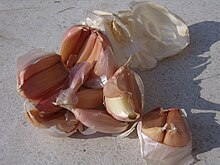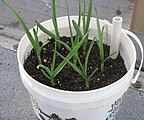(Allium sativum)
---Garlic is also known as the stinking rose.
---the word garlic comes from Old English garleac, meanong "spear leek"
---Allium sativum, commonly known as garlic, is a species in the onion family Alliaceae
---Its close relatives include the onion, shallot, leek,chive, and rakkyo. Garlic has been used throughout history for both culinary and medicinal purposes.
 |
| A bulb of garlic, not separated from the stem. |
 |
| Italian garlic The cloves are used for consumption (raw or cooked), or for medicinal purposes, and have a characteristic pungent, spicy flavor that mellows and sweetens considerably with cooking |
 |
| Garlic growing in a container. The leaves, and flowers (bulbils) on the head (spathe) are also edible, and being milder in flavor than the bulbs, they are most often consumed while immature and still tender. |
 |
| bulbils The leaves, and flowers (bulbils) on the head (spathe) are also edible, and being milder in flavor than the bulbs, they are most often consumed while immature and still tender. |
Properties: alternative, antibiotic, antispasmodic, diaphoretic, expectorant, stimulant.
What it affects: lungs, nerves, sinuses and circulation.
Preparation and amount:
Tincture: drink 30-60 drops(1/2-1 tsp.) 3-4 x a day
Juice: take 10-30 drops 3-4 x a day
Oil: take 2-3 drops or 1 tsp.
Syrup: drink 1 tbsp 3-4 x a day
Powder: take 5-10 #0 capsules (30-60 grains) 3-4 x a day
Purposes:
Garlic is one of the most powerful antiseptic substances ever discovered. It also one of the most readily available easily used medicinal substances. In 1950's, Soviet scientist found it to be equal to penicillin, yet without the harmful effects of that powerful drugs
Garlic is one of the most powerful antiseptic substances ever discovered. It also one of the most readily available easily used medicinal substances. In 1950's, Soviet scientist found it to be equal to penicillin, yet without the harmful effects of that powerful drugs
Internally, garlic detoxifies the entire body and protects against infections by enhancing immune function.It is good for virtually every infections and diseases.Its beneficial effect on blood circulation and heart action can bring relief for many common body complaints. It is used for all lung and respiratory ailments, colds, tuberculosis,blood diseases and fever; and it can be used as a tea or added to syrups for coughs.
It is used for arteriosclerosis, cancer, contagious disease, coughs, cramps, diverticulitis, emphysema, gas, heart problems, high blood pressure, indigestion, liver congestion rheumatism, sinus congestion, and ulcers.It aids in the treatment of arthritis, asthma, circulatory problems, cold and flu, digestive problems, heart dis orders, insomnia, liver diseases, sinusitis, ulcers, and yeast infections
Garlic regularizes the action of the liver and gallbladder. It stimulates the digestive organs and thereby relieves various problems associated with poor digestion. it helps stabilize blood sugar levels. As an expectorant, it is useful for chronic stomach and intestinal catarrh, as well as chronic bronchitis. A cold tea can be taken as an enema for worms and pinworms. A warm enema tea is good for bowel infections. Use the fresh extract oil or tea the raw cloves
Garlic is helpful in all intestinal infections, including dysentery, typhoid, cholera, and paratyphoid fever. It lowers blood lipid levels. It works to eliminate putrefactive intestinal bacteria. Because garlic lowers blood pressure, it helps to counteract arteriosclerosis.
Externally, garlic is used for ringworm, skin parasites, tumors and warts.
Warning:
People who take anticoagulant (blood-thinning) drugs should not take garlic, since it also thins the blood somewhat.
Plant Description:
Garlic is a perennial that originally came from central Asia, and is now cultivated throughout the world. It can grow 2 feet high or more. The most important part of this plant for medicinal purposes is the compound bulb. Each bulb is made up of 4 - 20 cloves, and each clove weighs about 1 gram. Garlic supplements can either be made from fresh, dried, aged, or garlic oil, and each may have different effects on the body.
No comments:
Post a Comment